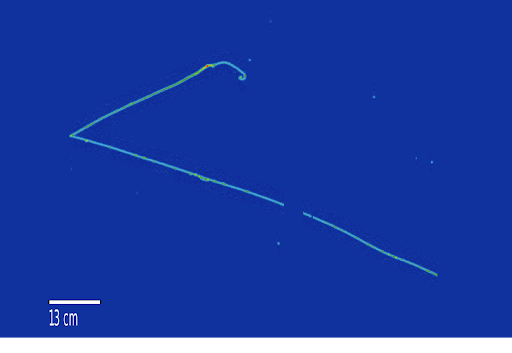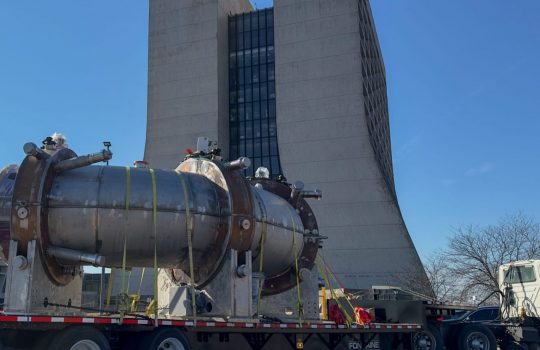Neutrinos have baffled scientists for decades as their properties and behavior differ from those of other known elementary particles. Their masses, for example, are much smaller than the masses measured for any other elementary matter particle we know. They also carry no electric charge and interact only very rarely – through the weak force — with matter. At Fermilab, a chain of accelerators generates neutrino beams so researchers can study neutrino properties and understand their role in the formation of the universe.
Scientists working on Fermilab’s MicroBooNE experiment have published a paper describing a search for a new – hidden – type of heavier neutrino that could help explain why the masses of ordinary neutrinos are so small. It could also provide important clues about the nature of dark matter. This search is the first of its kind performed with a type of particle detector known as a liquid-argon time projection chamber.
The MicroBooNE detector consists of a large tank of liquid argon, totaling 170 tons, located in an intense beam of neutrinos at Fermilab. The neutrinos originate in a beam produced by the lab’s accelerators. Some of these ordinary neutrinos will hit an argon nucleus in the tank, resulting in the production of other particles. The MicroBooNE detector then acts like a giant camera that records the particles produced in this collision.
A heavier type of neutrino – which has been hypothesized but never observed – could also be produced in the accelerator-generated beam. These heavier types of neutrinos, scientifically called “heavy neutral leptons,” would not interact through the weak force and therefore could not hit an argon nucleus in the same way as ordinary neutrinos do. They could, however, leave a hint of their existence if they decayed into known particles inside the MicroBooNE detector.

The display shows the decay of a heavy neutrino as it would be measured in the MicroBooNE detector. Scientists use such simulations to understand what a signal in data would look like. Image: MicroBooNE collaboration
To find such signatures of heavy neutrinos, MicroBooNE scientists devised a new method that helps them distinguish the heavy neutrino decays from ordinary neutrino scatterings on argon, and it has a lot to do with timing.
The Fermilab neutrino beam is not a continuous stream of particles. Rather, it is pulsed, and the experimenters know when these neutrino pulses are supposed to arrive at the MicroBooNE detector: The heavy neutrinos would be more massive and therefore slower than the ordinary neutrinos – a well-tested prediction of special relativity. The trick is therefore to wait just long enough — until the ordinary neutrinos in a pulse have passed through and only heavy neutrinos could arrive.
In the MicroBooNE detector, a heavy neutrino would appear to come out of nowhere. The only traces of its appearance would be tracks from two charged particles emerging from its decay – a muon and a pion (see figure). Using the measured angles and energies of these two daughter particles, the mass of the invisible parent particle – assumed to be the heavy neutrino — can be calculated.
After sifting through all the MicroBooNE data, scientists found that only a handful of heavy-neutrino candidates remained. Scientists found that the origin of these candidates is consistent with being muons from cosmic rays constantly bombarding the MicroBooNE detector. In very rare cases, such a muon can mimic the two charged particles from a heavy neutral lepton.
The heavy neutrinos – if they exist – are therefore still hiding. MicroBooNE’s results are expressed as a limit on the strength of the coupling – or mixing – of the hidden neutrinos with ordinary neutrinos. In this way, the sensitivity of the MicroBooNE detector can be translated into stringent constraints on models that predict hidden neutrino states, leading to better predictions. The short-baseline liquid-argon neutrino experiments at Fermilab are going to collect much more data in the coming years. Heavy neutrinos might not be able to hide much longer.
Fermilab is a DOE national laboratory supported by the Office of Science.
Owen Goodwin and Davide Porzio are Ph.D. students and Stefan Söldner-Rembold is a professor, all at the University of Manchester. Yun-Tse Tsai is an associate scientist at SLAC National Accelerator Laboratory.



